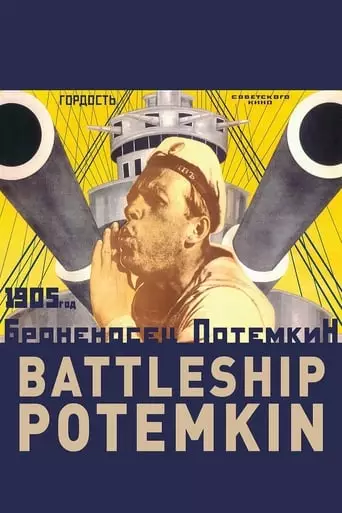A dramatized account of a great Russian naval mutiny and a resultant public demonstration, showing support, which brought on a police massacre. The film had an incredible impact on the development of cinema and is a masterful example of montage editing.
Directed by Sergei Eisenstein, Battleship Potemkin is a seminal work in the history of cinema, renowned for its innovative use of montage and its powerful portrayal of revolutionary fervor. The film is structured into five distinct acts:
- Men and Maggots: The sailors aboard the battleship Potemkin endure deplorable conditions, including being served rotten meat. Their grievances set the stage for rising discontent.
- Drama on the Deck: The crew’s frustration culminates in a mutiny against their oppressive officers. The uprising leads to the death of the sailors’ leader, Vakulinchuk, who becomes a martyr for the cause.
- A Dead Man Calls for Justice: Vakulinchuk’s body is brought to the port city of Odessa, where citizens mourn him, symbolizing the collective yearning for justice and change.
- The Odessa Steps: In one of the most iconic sequences in film history, Tsarist soldiers massacre civilians on the Odessa Steps, depicting the brutal repression of the populace.
- One Against All: The rebellious battleship faces the Tsar’s fleet. However, in a climactic moment of solidarity, the fleet’s sailors refuse to engage, joining the mutiny and signaling a broader revolutionary spirit.
Eisenstein’s masterful direction employs montage to evoke emotional responses, particularly evident in the harrowing Odessa Steps sequence. The film’s stark imagery and dynamic editing serve as a powerful propaganda tool, illustrating the collective struggle against tyranny.
Main Themes in Battleship Potemkin
The film delves into several profound themes:
- Revolution and Collective Action: It portrays the potency of unified resistance against oppressive regimes, emphasizing the role of the masses in enacting change.
- Martyrdom and Inspiration: Vakulinchuk’s death serves as a catalyst, inspiring widespread support for the revolutionary cause and highlighting the impact of individual sacrifice.
- Oppression and Brutality: The merciless actions of the Tsarist forces, especially during the Odessa Steps massacre, underscore the cruelty of autocratic power.
- Solidarity and Brotherhood: The unification of sailors and civilians reflects the strength found in solidarity, transcending individual differences for a common goal.
Impact of the Movie
Battleship Potemkin has left an indelible mark on the cinematic landscape. Its innovative use of montage influenced filmmakers worldwide, demonstrating how editing could manipulate time, space, and emotional intensity. The Odessa Steps sequence, in particular, has been studied and referenced extensively, showcasing the power of visual storytelling. Despite being a product of Soviet propaganda, the film’s artistic achievements have been universally acknowledged, earning it a place among the greatest films ever made. Its depiction of revolutionary zeal resonated globally, inspiring political movements and other cinematic works.
7 Reasons to Watch Battleship Potemkin (1925)
- Historical Significance: As a pioneering work of Soviet cinema, it offers insight into early 20th-century filmmaking and the political climate of the era.
- Innovative Use of Montage: Eisenstein’s editing techniques revolutionized film language, making it a must-watch for enthusiasts of cinematic form.
- Iconic Sequences: The Odessa Steps scene remains one of the most analyzed and referenced moments in film history, exemplifying the power of visual narrative.
- Emotional Resonance: The film’s portrayal of human struggle and resilience evokes a profound emotional response, engaging viewers on a deep level.
- Cultural Influence: Its themes of revolution and resistance have inspired countless works across various media, reflecting its enduring relevance.
- Technical Mastery: From cinematography to set design, the film exhibits a high level of craftsmanship that continues to impress modern audiences.
- Educational Value: For students of film and history, it provides a rich resource for understanding the interplay between art and politics.
How Will You Feel After Watching Battleship Potemkin (1925)?
Experiencing Battleship Potemkin is likely to leave you with a profound appreciation for the art of filmmaking and a heightened awareness of the power of collective action. The film’s intense emotional sequences and portrayal of human resilience against oppression may evoke feelings of inspiration and empathy. Its historical context and innovative techniques offer a thought-provoking journey, prompting reflection on both the evolution of cinema and the enduring themes of social justice and solidarity.
The Legacy of Battleship Potemkin
Battleship Potemkin continues to be a cornerstone of film studies and a benchmark for artistic and political cinema. Its bold experimentation with montage and narrative structure set a precedent for visual storytelling, influencing directors like Alfred Hitchcock, Francis Ford Coppola, and Brian De Palma. Beyond its technical achievements, the film serves as a timeless reminder of the power of unity and the potential of cinema as a tool for social and political commentary.
The film’s influence extends beyond the screen, inspiring political movements and cultural discussions about justice, resistance, and collective action. Its enduring relevance ensures that Battleship Potemkin remains a vital part of both cinematic and historical discourse.

